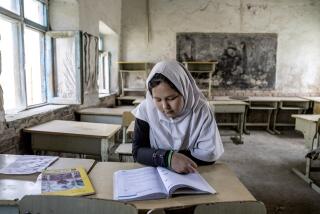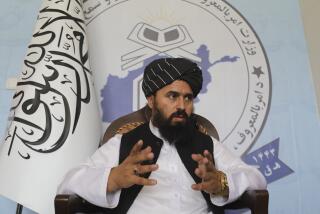Afghan Women Slowly Joining Western Sisters at Work
- Share via
KABUL, Afghanistan — Muslim women here are emerging from behind the folds of the traditional chador and joining their Western sisters in the working world.
The chador, the head-to-toe covering with an opening for the eyes, is still much in evidence in the villages of Afghanistan, but in Kabul it is seen much less than it was a decade ago.
The gradual decline of the garment is regarded as a sign of modernization on the part of the Afghan government, which is striving to overcome a legacy of poverty and illiteracy. Besides, since scores of thousands of young men are in uniform in this seventh year of a guerrilla war, women are needed in the military and the labor force. Thousands of women have taken up arms against the rebels, and even some village women have taken factory jobs.
Changing Since 1978
Changes in the status of women have been going on since the overthrow of the monarchy in the Soviet-backed coup of 1978. This evolution has become one of the proudest boasts of the revolutionary leaders, who say women have been freed from the feudal conditions that kept them subjugated and unable to acquire an education or work outside the home.
Still, only a few women have achieved any political standing, and there was an angry backlash when the government tried to make literacy training compulsory for women, as it is for men.
In schools, the ratio is still two boys to one girl, and this illustrates the tendency of many parents to keep their daughters home.
Afghanistan’s literacy rate, a shocking 10% before the 1978 revolution, has increased slowly to 30%, officials recently told a group of visiting reporters. They said this is far too low, and literacy training has one of the highest priorities in the government’s new five-year plan.
85,000 Being Taught
Before the revolution, these officials said, only about 2% of the women could read and write; now more than 85,000 women are being taught.
The number of women in industry has multiplied by a factor of five, as official policy has prevailed over conservative religious beliefs.
Haroge Begom’s experience is an example of what is taking place. She operates concrete-pouring machinery and overhead cranes in a Kabul factory that makes prefabricated housing, earning 2,700 afghanis a month, about $20 at the unofficial exchange rate. She began working at the age of 9, as a seamstress, and took the factory job six years ago when she was 16.
In Jalalabad, a new olive oil factory has hired women for factory work for the first time in the history of the province. Factory director Hakim Baburi said there are 200 women on his payroll. He said that they are not allowed to work past 8 p.m. and that special arrangements have been made to care for their children.
More Jobs Held by Women
Amondoddin Salyed Amin, a government official who was once president of the Afghan Textile Co., said that there were no women in the firm’s four plants in the late 1950s but that now half the jobs in the spinning department are held by women.
“In the next 10 years,” he said, “women will be running the textile factories.”
The new leader of Afghanistan, Najib, recently singled out women for special notice in a speech on building up military effectiveness. “Afghan girls,” he said, “the army needs your sympathetic and kind hands. Nurses and doctors are needed to help the brave and heroic soldiers.”
An estimated 8,000 women are already serving in village militias, called self-defense groups. They are taught to use weapons, officials said.
Political power is another matter, apparently. Only one woman, a longtime close associate of Babrak Karmal, the former leader, is a member of the Politburo of the ruling People’s Democratic Party. She is Dr. Anahita Ratebzad, a former nurse in Chicago, who was the first woman elected to Parliament in her country.
Understanding Required
“We have to learn a lot to be able to improve the lot of our women,” she said in a recent speech. “This requires a deep understanding of the traditions cherished by our people in order to be able to work among them.”
She said the government’s literacy training is “not quite satisfactory” and called for more classes in residential neighborhoods and in the countryside, where the need is greatest.
About 10% of the 150,000 members of the ruling party are women. At a recent meeting of the National Fatherland Front, a coalition of mass organizations supporting the regime, only one woman was on the podium with the dozens of men there.
An East German woman, a technician working in Jalalabad, recently urged faster progress. In a talk with an Afgan government official, she said: “You’re a thousand years behind in some ways. There’s no time to lose.”
The official agreed. “We need a cultural revolution,” he said.
Meanwhile, at the national handicraft exhibition, 24 women were hand-looming a rug that will eventually measure 200 square yards when it is finished.
The job moves along at the rate of two square inches a day across its width. The women calculate that it will take them 18 months to finish--suggesting that they, at least, have a great deal of patience.
More to Read
Sign up for Essential California
The most important California stories and recommendations in your inbox every morning.
You may occasionally receive promotional content from the Los Angeles Times.










